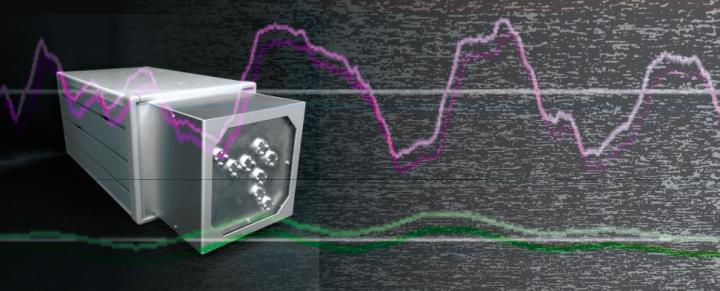Detecting heartbeats remotely with millimeter-wave radar
January 22, 2016

Japanese researchers have developed a way to measure heartbeats remotely in real time with as much accuracy as electrocardiographs. (credit: Kyoto University)
A radar system that measures heartbeats remotely in real time and with as much accuracy as electrocardiographs has been developed by researchers at the Kyoto University Center of Innovation and Panasonic Corporation,
The results were published in an open-access paper in the journal IEEE Transactions on Biomedical Engineering.
The researchers say this new approach will allow for developing long-term monitoring and “casual sensing” — taking measurements as people go about their daily activities, without having to attach uncomfortable electrodes or sensors to the patient’s body. People will also be able to monitor their cardio health status themselves.
The remote sensing system transmits and receives radar signals in the 24 GHz band* using “ultra-wideband” (UWB) modulation, which is known for its ability to detect specific signals in a noisy radio-frequency environment. A unique signal analysis algorithm extracts data from radar signals reflected from the body to detect heart rate and heart-rate variability (time derivative). Future use for detection of breathing, body movement, and other data from the body is also possible, the researchers suggest.
* The 24 GHz radar band is also used for new automotive radar sensors in the U.S. and Europe for collision detection, obstacle detection, blind-spot monitoring, and automatic cruise control for cars, including self-driving cars. Speculation: it may be possible to use the new UWB-based technology on semi-automated and fully automated vehicles for detecting and tracking humans and pets in the road in real time, based on heartbeat and other characteristics, and compensating for a subject’s movement. The remote feature also suggests possible future covert use in remote polygraph, airport screening, espionage, and other applications. The authors have been asked to technically comment on these uses.
Abstract of Feature-based Correlation and Topological Similarity for Interbeat Interval Estimation using Ultra-Wideband Radar
The objectives of this paper are to propose a method that can accurately estimate the human heart rate using an ultra-wideband radar system, and to determine the performance of the proposed method through measurements. The proposed method uses the feature points of a radar signal to estimate the heart rate efficiently and accurately. Fourier- and periodicity-based methods are inappropriate for estimation of instantaneous heart rates in real time because heartbeat waveforms are highly variable, even within the beat-to-beat interval. We define six radar waveform features that enable correlation processing to be performed quickly and accurately. In addition, we propose a feature topology signal that is generated from a feature sequence without using amplitude information. This feature topology signal is used to find unreliable feature points, and thus to suppress inaccurate heart rate estimates. Measurements were taken using ultra-wideband radar, while simultaneously performing electro-cardiography measurements in an experiment that was conducted on nine participants. The proposed method achieved an average root-mean-square error in the interbeat interval of 7.17 ms for the nine participants. The results demonstrate the effectiveness and accuracy of the proposed method. The significance of this work for biomedical research is that the proposed method will be useful in the realization of a remote vital signs monitoring system that enables accurate estimation of heart-rate variability, which has been used in various clinical settings for the treatment of conditions such as diabetes and arterial hypertension.
